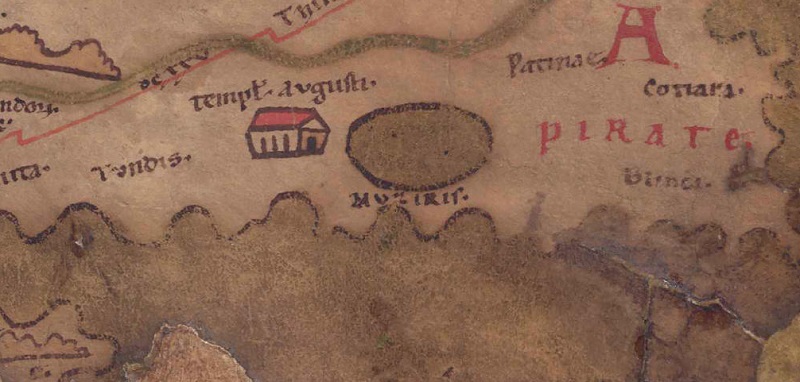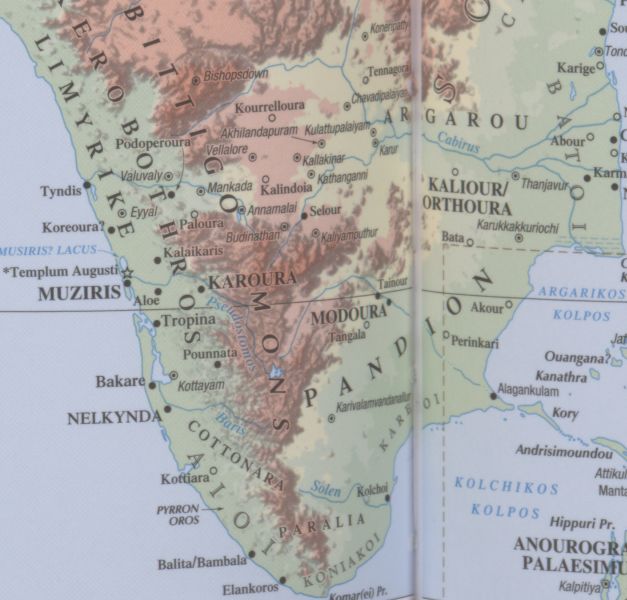
Tabula Peutingeriana – Einzelanzeige
| Toponym TP (aufgelöst): | Mvziris (Muziris) |
| Name (modern): | Cranganūr |
| Bild: |  Zum Bildausschnitt auf der gesamten TP |
| Toponym vorher | |
| Toponym nachher | |
| Alternatives Bild | --- |
| Bild (Barrington 2000) |
 |
| Bild (Scheyb 1753) | --- |
| Bild (Welser 1598) | --- |
| Bild (MSI 2025) | --- |
| Pleiades: | https://pleiades.stoa.org/places/50146 |
| Großraum: | Indien |
| Toponym Typus: | isolierter Name |
| Planquadrat: | 11C5 |
| Farbe des Toponyms: | schwarz |
| Vignette Typus : | --- |
| Itinerar (ed. Cuntz): |
|
| Alternativer Name (Lexika): | Muziris (DNP); Periplus 53: Μούζιρις; Ptol. 7, 1, 8; 8, 26, 4: Μουζιρὶς ἐμπ |
| RE: | Muziris |
| Barrington Atlas: | Muziris (5 D4) |
| TIR / TIB /sonstiges: |
|
| Miller: | Mvziris |
| Levi: |
|
| Ravennat: | Maziris (p. 15.64) |
| Ptolemaios (ed. Stückelberger / Grasshoff): | Μουζιρὶς ἐμπόριον (7,1,8; 8,26,4) |
| Plinius: |
|
| Strabo: |
|
| Autor (Hellenismus / Späte Republik): |
|
| Datierung des Toponyms auf der TP: | frühe Kaiserzeit (einschließlich Flavier) |
| Begründung zur Datierung: | Die Quellenlage (vgl. Kommentar) legt eine Datierung des Eintrages in die frühe Kaiserzeit nahe. |
| Kommentar zum Toponym: |
Anders als das (fälschlicherweise) im nordwestindischen Raum platzierte Nincildae ist Muziris (ebenso wie Tundis) als isoliertes Toponym ohne eine Anbindung an andere Hafenplätze oder an das Hinterland eingetragen. Auffällig und auch der tatsächlichen geographischen Lage entsprechend, liegt der Ort an einem größeren Binnengewässer (Lacus Musiris). Glaubwürdig, wenn auch sonst nicht belegt, ist die Existenz eines in der Nähe gelegenen templum Augusti, wie es auch für das mesopotamische Vologesias, einem von Kaufleuten aus dem Römischen Reich intensiv frequentierten Stapelplatz, gesichert ist. Tomaschek bezeichnet dieses Gebäude als „Pagode“. |
| Literatur: |
Wilhelm Tomaschek, Südasiatische Miscellen, in: WZKM 4, 1890, 47-60, hier 56; Miller, Itineraria, 790; Ders., Mappaemunidi IV, 36; Albert Herrmann, in: RE XVI / 1, 1933, 989 s.v. Muziris; Peter Francis, Asia’s Maritime Bead Trade: 300 B.C. to the Presentt, Honululu 2002, 119; Steven E. Sidebotham, Roman Economic Policy in the Erythra Thalassa. 30 B.C.-A.D. 217, Leiden 1986 (= Mnemosyne 91), 23f.; Lionel Casson, The Periplus Maris Erythraei. Text with Introduction Translation and Commentary, Princeton 1989, 296-298; Klaus Karttunen, in: DNP s.v. Muziris, http://dx.doi.org/10.1163/1574-9347_dnp_e813630; Grant Parker, The Making of Roman India, Cambridge 2008, 173f.; Hermann Kulke / Dietmar Rothermund, Geschichte Indiens. Von der Induskultur bis heute, München 2010 (2. Aufl.); Steven E. Sidebotham, Berenike and the Ancient Maritime Spice Route, Berkeley / Los Angeles 2011 (= The California World History Library 18), 190f.; Veerasamy Selvakumar / Kuttickat P. Shajan / Roberta Tomber, Archaeological Investigations at Pattanam, Kerala: New Evidence for the Location of Ancient Muziris, in: Roberta Tomber / Lucy Blue / Shinu Abraham (Hrg.), Migration, Trade and Peoples, Part 1: Indian Commerce and the Archaeology of Western India, London 2010, 29-41; Raoul McLaughlin, The Roman Empire and the Indian Ocean. The Ancient World Economy and the Kingdoms of Africa, Arabia and India, Barnsley 2014, 48-50. 55. 173f.; Michael A. Speidel, Augustus-Tempel in Indien und im Partherreich? Zur Tabula Peutingeriana und zum römischen Kaiserkult ausserhalb des Römischen Reiches, in: Anne Kolb / Marco Vitale (Hrg.), Kaiserkult in den Provinzen des Römischen Reiches. Organisation, Kommunikation und Repräsentation, Berlin 2016, 101-121; Manuel Albaladejo Vivero, Emporion and Chora in the Periplus of the Erythraean Sea and Related Sources, in: Orbis Terrarum 15, 2017, 11-22, hier 18; Veerasamy Selvakumar, Ancient Ports of Kerala: An Overview, in: Kuzhippalli S. Matthew (Hrg.), Imperial Rome, Indian Ocean Regions and Muziris. New Perspectives on Maritime Trade, New York 2017, 269-296, hier 281-285 (mit Verweisen auf die alttamilische Sangam-Literatur); Pius Malekandathil, Muziris and the Trajectories of Maritime Trade in the Indian Ocean in the First Millennium CE, ebd., 339-368 (ebenfalls mit Quellenangaben); Anitta G. Kunappilly, The Trade of the Port of Muziris in Ancient Times, in: Journal of Maritime History 30/3, 2018, 519-525; Federico De Romanis, The Indo-Roman Pepper Trade and the Muziris Papyrus, Oxford 2020 (= Oxford Studies on the Roman Economy), 115-118 u.ö. |
| Letzte Bearbeitung: | 09.07.2025 16:39 |
Cite this page:
https://www1.ku.de/ggf/ag/tabula_peutingeriana/einzelanzeige.php?id=1945 [zuletzt aufgerufen am 14.12.2025]